Extraction of Electron and Hole Drift Velocities in Thin 4H-SiC PIN Detectors Using High-Frequency Readout Electronics
Abstract
1. Introduction
2. Materials and Methods
2.1. Silicon Carbide Sensors
2.2. High-Frequency Readout Electronics
2.3. Feature Extraction
2.4. Simulation Framework
2.4.1. TCAD Simulations
2.4.2. Allpix2 Simulations
2.4.3. QUCS Simulations
3. Results
3.1. Pulsed UV Laser
3.2. Proton Beams at MedAustron
3.3. Alpha Particles
3.4. Saturation Velocities
3.5. Comparison with Simulations
4. Discussion
5. Conclusions
Author Contributions
Funding
Institutional Review Board Statement
Informed Consent Statement
Data Availability Statement
Acknowledgments
Conflicts of Interest
References
- Gaggl, P.; Bergauer, T.; Göbel, M.; Thalmeier, R.; Villa, M.; Waid, S. Charge collection efficiency study on neutron-irradiated planar silicon carbide diodes via UV-TCT. Nucl. Instrum. Methods Phys. Res. Sect. A Accel. Spectrometers Detect. Assoc. Equip. 2022, 1040, 167218. [Google Scholar] [CrossRef]
- Gsponer, A.; Gaggl, P.; Burin, J.; Thalmeier, R.; Waid, S.; Bergauer, T. Neutron radiation induced effects in 4H-SiC PiN diodes. J. Instrum. 2023, 18, C11027. [Google Scholar] [CrossRef]
- Babcock, R. Radiation Damage in SiC. IEEE Trans. Nucl. Sci. 1965, 12, 43–47. [Google Scholar] [CrossRef]
- Nava, F.; Bertuccio, G.; Cavallini, A.; Vittone, E. Silicon carbide and its use as a radiation detector material. Meas. Sci. Technol. 2008, 19, 102001. [Google Scholar] [CrossRef]
- De Napoli, M. SiC detectors: A review on the use of silicon carbide as radiation detection material. Front. Phys. 2022, 10, 898833. [Google Scholar] [CrossRef]
- Jungclaussen, H. Analyse der impulsform von Silizium-Detektoren. Nucl. Instrum. Methods 1967, 51, 210–212. [Google Scholar] [CrossRef]
- Zulliger, H.; Norris, C.; Sigmon, T.; Pehl, R. Electric field profile and electron drift velocities in lithium drifted silicon. Nucl. Instrum. Methods 1969, 70, 125–133. [Google Scholar] [CrossRef]
- Canali, C.; Ottaviani, G.; Alberigi Quaranta, A. Drift velocity of electrons and holes and associated anisotropic effects in silicon. J. Phys. Chem. Solids 1971, 32, 1707–1720. [Google Scholar] [CrossRef]
- Eremin, V.; Strokan, N.; Verbitskaya, E.; Li, Z. Development of transient current and charge techniques for the measurement of effective net concentration of ionized charges (Neff) in the space charge region of p-n junction detectors. Nucl. Instrum. Methods Phys. Res. Sect. A Accel. Spectrometers Detect. Assoc. Equip. 1996, 372, 388–398. [Google Scholar] [CrossRef]
- Li, Z.; Li, C.J.; Eremin, V.; Verbitskaya, E. Direct observation and measurements of neutron-induced deep levels responsible for Neff changes in high-resistivity silicon detectors using TCT. Nucl. Instrum. Methods Phys. Res. Sect. A Accel. Spectrometers Detect. Assoc. Equip. 1997, 388, 297–307. [Google Scholar] [CrossRef]
- Kramberger, G.; Cindro, V.; Mandić, I.; Mikuž, M.; Milovanović, M.; Zavrtanik, M.; Žagar, K. Investigation of Irradiated Silicon Detectors by Edge-TCT. IEEE Trans. Nucl. Sci. 2010, 57, 2294–2302. [Google Scholar] [CrossRef]
- Burin, J.; Gaggl, P.; Waid, S.; Gsponer, A.; Bergauer, T. TCAD Parameters for 4H-SiC: A Review. arXiv 2025, arXiv:2410.06798. [Google Scholar] [CrossRef]
- Sadrozinski, H.W.; Baselga, M.; Ely, S.; Fadeyev, V.; Galloway, Z.; Ngo, J.; Parker, C.; Schumacher, D.; Seiden, A.; Zatserklyaniy, A.; et al. Sensors for ultra-fast silicon detectors. Nucl. Instrum. Methods Phys. Res. Sect. A Accel. Spectrometers Detect. Assoc. Equip. 2014, 765, 7–11. [Google Scholar] [CrossRef]
- Allaire, C.; Benitez, J.; Bomben, M.; Calderini, G.; Carulla, M.; Cavallaro, E.; Falou, A.; Flores, D.; Freeman, P.; Galloway, Z.; et al. Beam test measurements of Low Gain Avalanche Detector single pads and arrays for the ATLAS High Granularity Timing Detector. J. Instrum. 2018, 13, P06017. [Google Scholar] [CrossRef]
- Gundacker, S.; Turtos, R.M.; Auffray, E.; Paganoni, M.; Lecoq, P. High-frequency SiPM readout advances measured coincidence time resolution limits in TOF-PET. Phys. Med. Biol. 2019, 64, 055012. [Google Scholar] [CrossRef] [PubMed]
- Krake, M.; Nadig, V.; Schulz, V.; Gundacker, S. Power-efficient high-frequency readout concepts of SiPMs for TOF-PET and HEP. Nucl. Instrum. Methods Phys. Res. Sect. A Accel. Spectrometers Detect. Assoc. Equip. 2022, 1039, 167032. [Google Scholar] [CrossRef]
- Schumm, B.A.; Martinez-McKinney, F.; Morris, T.; Mudford, S.; Nizam, M.; Padilla, R.; Shin, K.W.; Jacobson, B.; Torrecilla, I.S.; Smedley, J. Development of ultra-fast diamond-sensor based systems for advanced accelerator diagnostics. In Proceedings of the IBIC2024, Beijing, China, 9–13 September 2024; JACoW Publishing: Geneva, Switzerland, 2024; pp. 664–668. [Google Scholar] [CrossRef]
- Mini-Circuits. PMA3-14LN+. 2025. Available online: https://www.minicircuits.com/WebStore/dashboard.html?model=PMA3-14LN%2B (accessed on 28 September 2025).
- Shockley, W. Currents to Conductors Induced by a Moving Point Charge. J. Appl. Phys. 1938, 9, 635–636. [Google Scholar] [CrossRef]
- Ramo, S. Currents Induced by Electron Motion. Proc. IRE 1939, 27, 584–585. [Google Scholar] [CrossRef]
- Martini, M.; Mayer, J.; Zanio, K. Drift Velocity and Trapping in Semiconductors—Transient Charge Technique. In Applied Solid State Science; Elsevier: Amsterdam, The Netherlands, 1972; pp. 181–261. [Google Scholar] [CrossRef]
- Gsponer, A.; Knopf, M.; Gaggl, P.; Burin, J.; Waid, S.; Bergauer, T. Measurement of the electron-hole pair creation energy in a 4H-SiC p-n diode. Nucl. Instrum. Methods Phys. Res. Sect. A Accel. Spectrometers Detect. Assoc. Equip. 2024, 1064, 169412. [Google Scholar] [CrossRef]
- Kramberger, G. Advanced TCT setups. In Proceedings of the the 23rd International Workshop on Vertex Detectors, Macha Lake, Czech Republic, 15–19 September 2014. [Google Scholar] [CrossRef]
- Gaggl, P. Improving TCAD simulation of 4H silicon carbide particle detectors. In Proceedings of the 42nd RD50 Workshop, Tivat, Montenegro, 20–23 June 2023; Available online: https://indico.cern.ch/event/1270076/contributions/5450202/ (accessed on 28 September 2025).
- Onder, S.; Gaggl, P.; Burin, J.; Gsponer, A.; Knopf, M.; Waid, S.; Moffat, N.; Pellegrini, G.; Bergauer, T. Design and simulation of a 4H-SiC low gain avalanche diode with trench-isolation. Nucl. Instrum. Methods Phys. Res. Sect. A Accel. Spectrometers Detect. Assoc. Equip. 2025, 1080, 170740. [Google Scholar] [CrossRef]
- Spannagel, S.; Wolters, K.; Hynds, D.; Alipour Tehrani, N.; Benoit, M.; Dannheim, D.; Gauvin, N.; Nürnberg, A.; Schütze, P.; Vicente, M. Allpix2: A modular simulation framework for silicon detectors. Nucl. Instrum. Methods Phys. Res. Sect. A Accel. Spectrometers Detect. Assoc. Equip. 2018, 901, 164–172. [Google Scholar] [CrossRef]
- Sridhara, S.G.; Devaty, R.P.; Choyke, W.J. Absorption coefficient of 4H silicon carbide from 3900 to 3250 Å. J. Appl. Phys. 1998, 84, 2963–2964. [Google Scholar] [CrossRef]
- Ishikawa, R.; Tanaka, H.; Kaneko, M.; Kimoto, T. Experimental and Theoretical Study on Anisotropic Electron Mobility in 4H-SiC. Phys. Status Solidi B 2023, 260, 2300275. [Google Scholar] [CrossRef]
- Ishikawa, R.; Tanaka, H.; Kaneko, M.; Kimoto, T. Origin of hole mobility anisotropy in 4H-SiC. J. Appl. Phys. 2024, 135, 075704. [Google Scholar] [CrossRef]
- Qucs-S. Qucs with SPICE. 2025. Available online: https://ra3xdh.github.io/ (accessed on 28 September 2025).
- Nilsson, H.E.; Bellotti, E.; Brennan, K.; Hjelm, M. A Full Band Monte Carlo Study of High Field Carrier Transport in 4H-SiC. In Proceedings of the ICSCRM’99: The International Conference on Silicon Carbide and Related Materials, Research Triangle Park, NC, USA, 10–15 October 1999; Trans Tech Publications Ltd.: Wollerau, Switzerland, 2000; Volume 338, pp. 765–768. [Google Scholar] [CrossRef]
- Zhao, J.H.; Gruzinskis, V.; Luo, Y.; Weiner, M.; Pan, M.; Shiktorov, P.; Starikov, E. Monte Carlo simulation of 4H-SiC IMPATT diodes. Semicond. Sci. Technol. 2000, 15, 1093. [Google Scholar] [CrossRef]
- Hjelm, M.; Nilsson, H.E.; Martinez, A.; Brennan, K.F.; Bellotti, E. Monte Carlo study of high-field carrier transport in 4H-SiC including band-to-band tunneling. J. Appl. Phys. 2003, 93, 1099–1107. [Google Scholar] [CrossRef]
- Riegler, W.; Rinella, G.A. Time resolution of silicon pixel sensors. J. Instrum. 2017, 12, P11017. [Google Scholar] [CrossRef]
- Canali, C.; Majni, G.; Minder, R.; Ottaviani, G. Electron and hole drift velocity measurements in silicon and their empirical relation to electric field and temperature. IEEE Trans. Electron Devices 1975, 22, 1045–1047. [Google Scholar] [CrossRef]
- Pomorski, M.; Delfaure, C.; Vaissiere, N.; Bensalah, H.; Barjon, J.; Pinault-Thaury, M.; Tromson, D.; Bergonzo, P. Characterization of the charge-carrier transport properties of IIa-Tech SC diamond for radiation detection applications. Phys. Status Solidi A 2015, 212, 2553–2558. [Google Scholar] [CrossRef]
- Schwierz, F. An electron mobility model for wurtzite GaN. Solid-State Electron. 2005, 49, 889–895. [Google Scholar] [CrossRef]
- Bellotti, E.; Bertazzi, F. Transport Parameters for Electrons and Holes. In Nitride Semiconductor Devices: Principles and Simulation; John Wiley & Sons, Ltd.: Hoboken, NJ, USA, 2007; Chapter 4; pp. 69–93. [Google Scholar] [CrossRef]






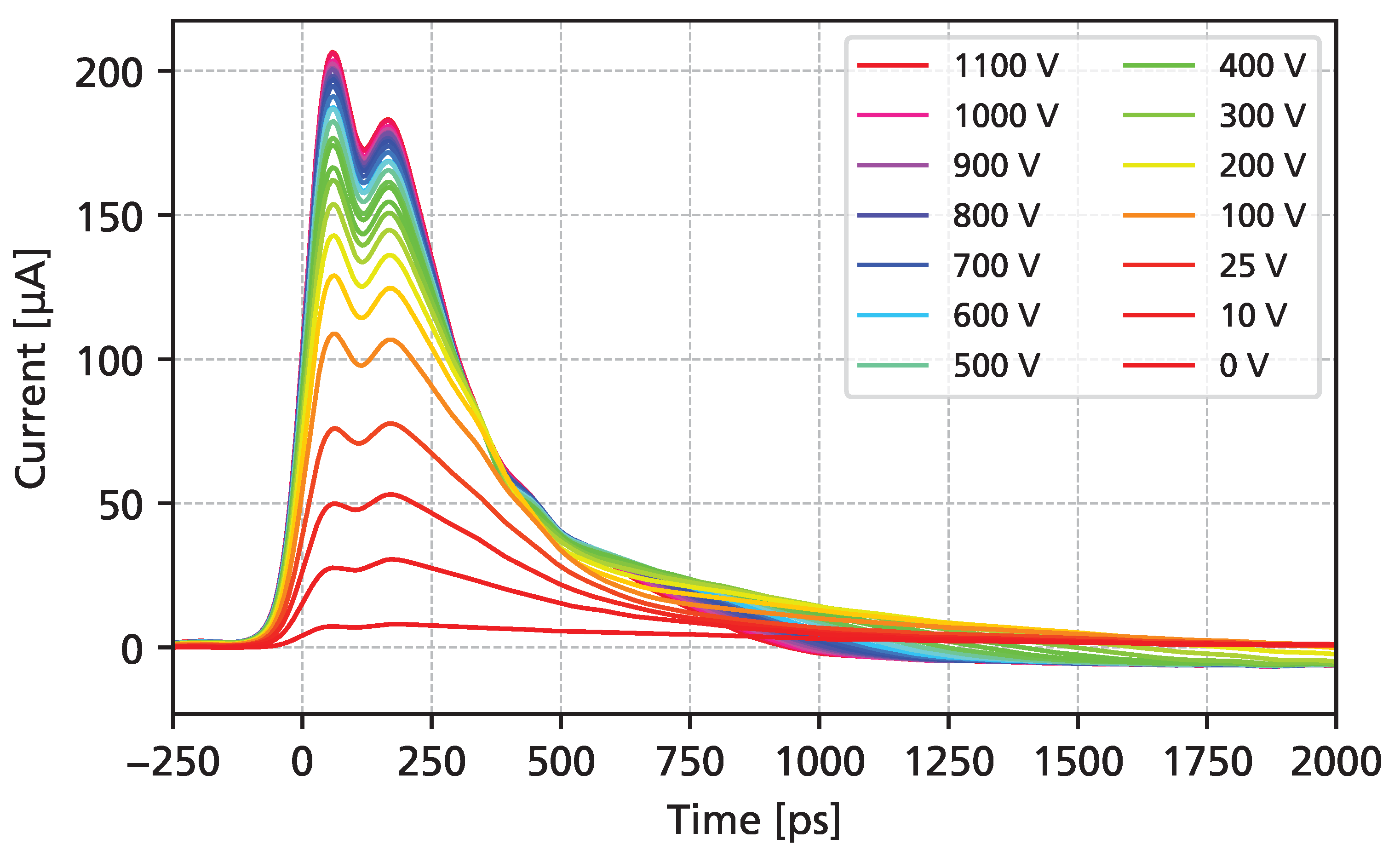

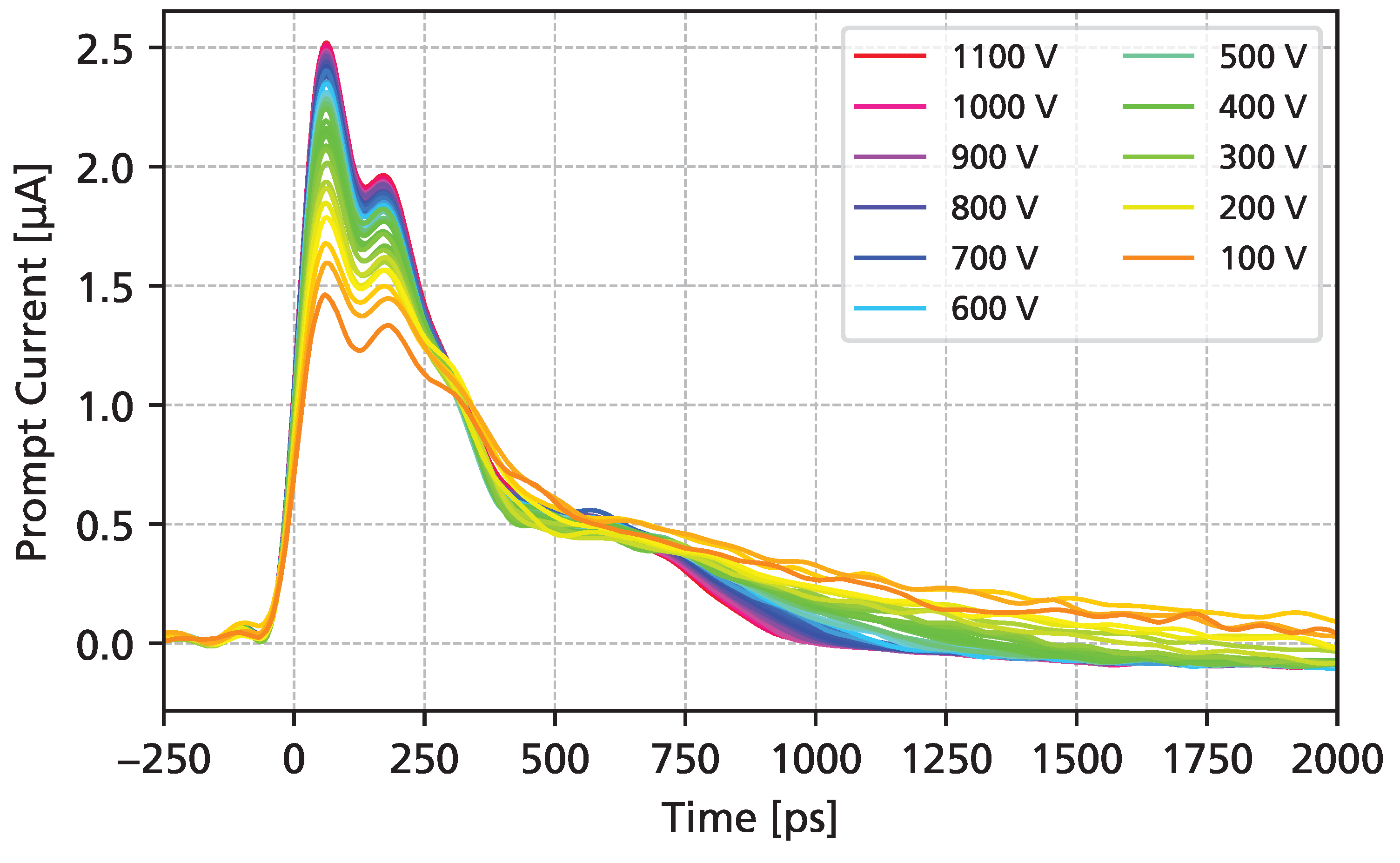

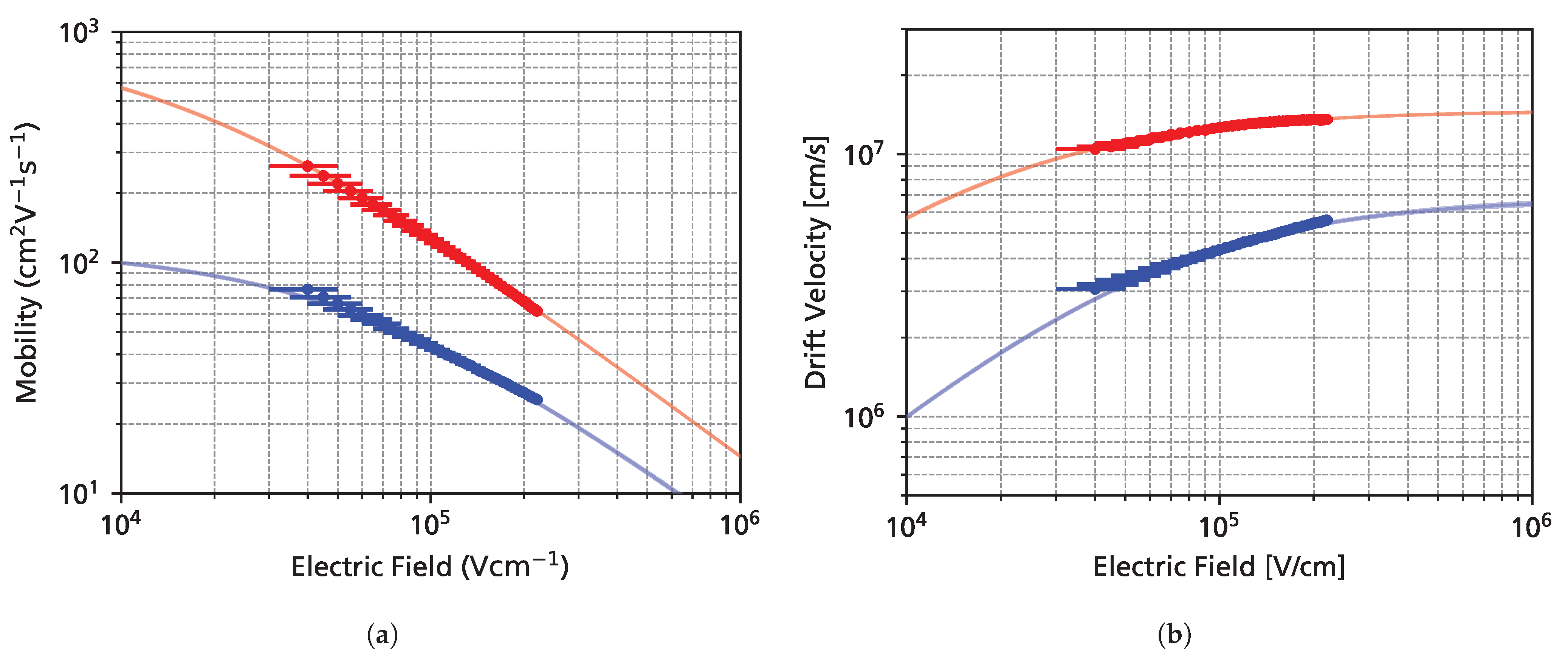
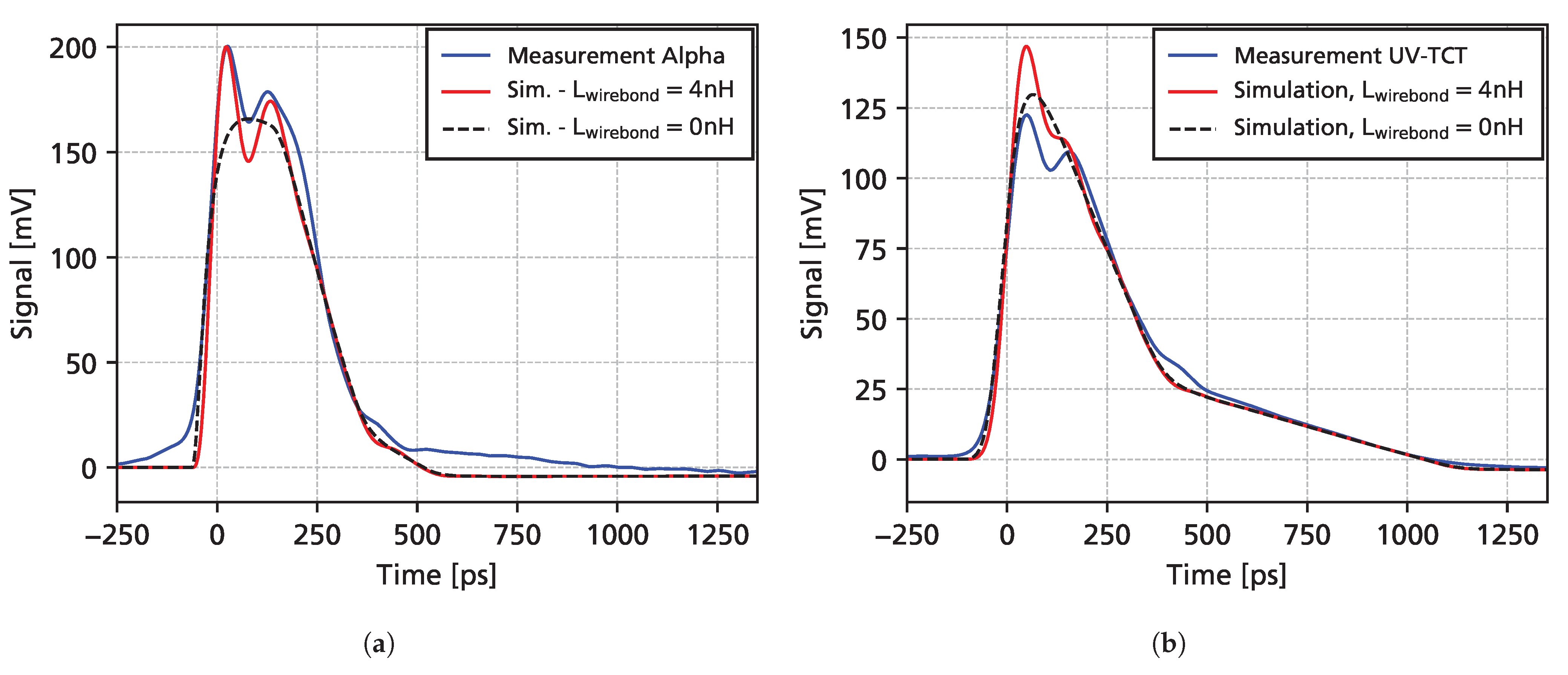
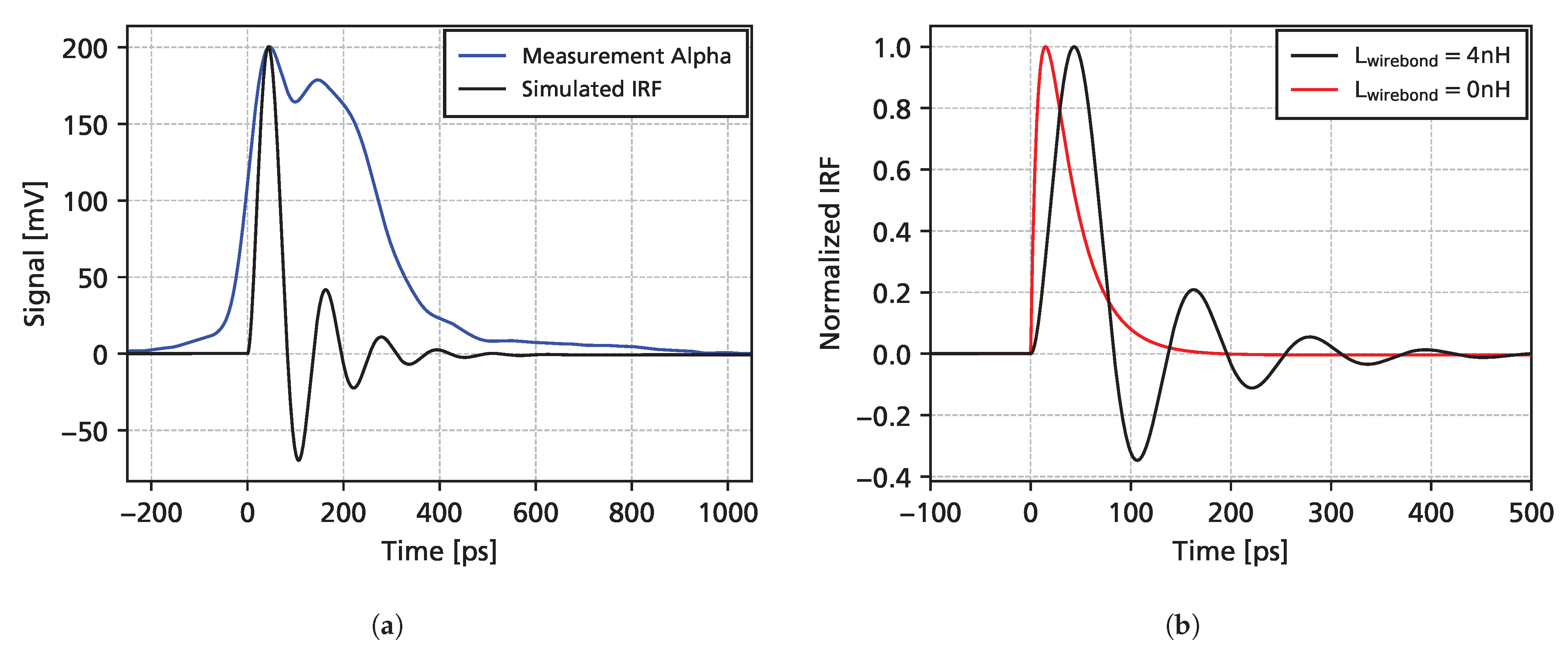
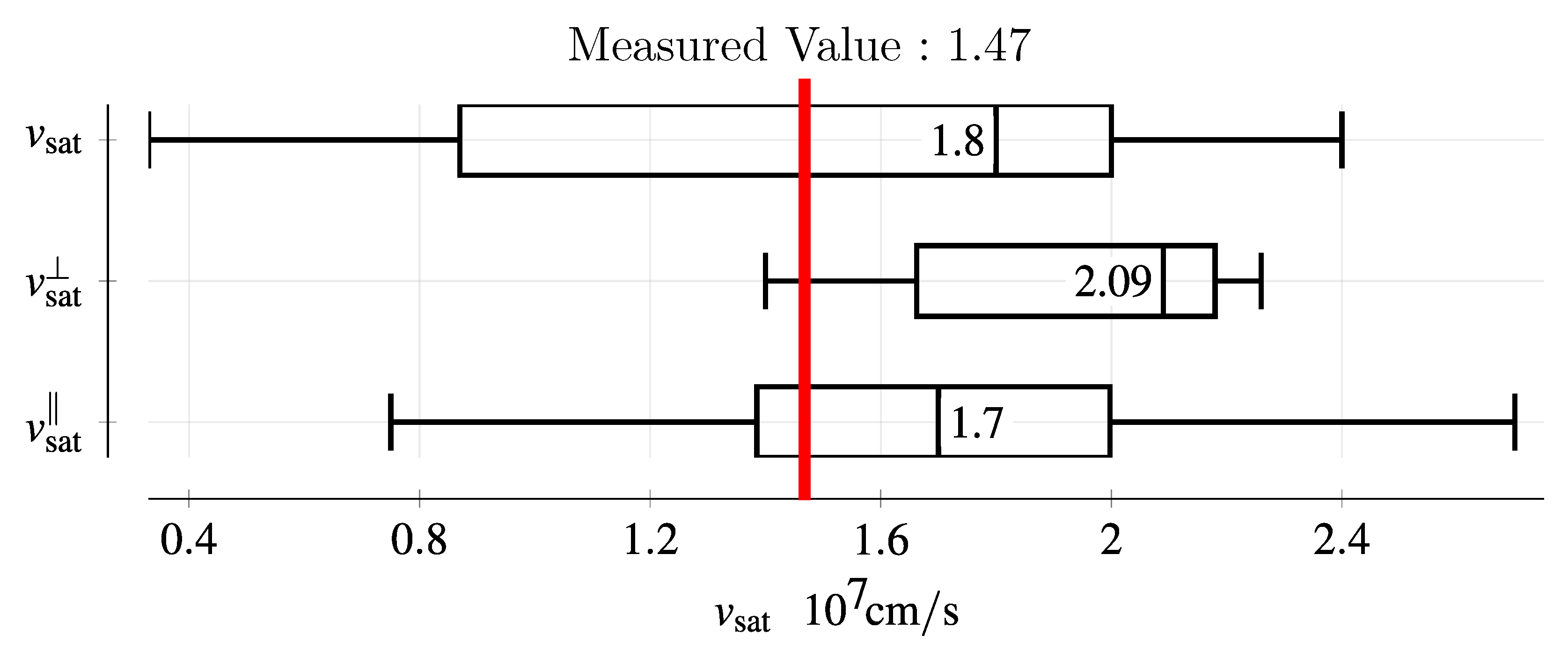
Disclaimer/Publisher’s Note: The statements, opinions and data contained in all publications are solely those of the individual author(s) and contributor(s) and not of MDPI and/or the editor(s). MDPI and/or the editor(s) disclaim responsibility for any injury to people or property resulting from any ideas, methods, instructions or products referred to in the content. |
© 2025 by the authors. Licensee MDPI, Basel, Switzerland. This article is an open access article distributed under the terms and conditions of the Creative Commons Attribution (CC BY) license (https://creativecommons.org/licenses/by/4.0/).
Share and Cite
Gsponer, A.; Onder, S.; Gundacker, S.; Burin, J.; Knopf, M.; Radmanovac, D.; Waid, S.; Bergauer, T. Extraction of Electron and Hole Drift Velocities in Thin 4H-SiC PIN Detectors Using High-Frequency Readout Electronics. Sensors 2025, 25, 7196. https://doi.org/10.3390/s25237196
Gsponer A, Onder S, Gundacker S, Burin J, Knopf M, Radmanovac D, Waid S, Bergauer T. Extraction of Electron and Hole Drift Velocities in Thin 4H-SiC PIN Detectors Using High-Frequency Readout Electronics. Sensors. 2025; 25(23):7196. https://doi.org/10.3390/s25237196
Chicago/Turabian StyleGsponer, Andreas, Sebastian Onder, Stefan Gundacker, Jürgen Burin, Matthias Knopf, Daniel Radmanovac, Simon Waid, and Thomas Bergauer. 2025. "Extraction of Electron and Hole Drift Velocities in Thin 4H-SiC PIN Detectors Using High-Frequency Readout Electronics" Sensors 25, no. 23: 7196. https://doi.org/10.3390/s25237196
APA StyleGsponer, A., Onder, S., Gundacker, S., Burin, J., Knopf, M., Radmanovac, D., Waid, S., & Bergauer, T. (2025). Extraction of Electron and Hole Drift Velocities in Thin 4H-SiC PIN Detectors Using High-Frequency Readout Electronics. Sensors, 25(23), 7196. https://doi.org/10.3390/s25237196





